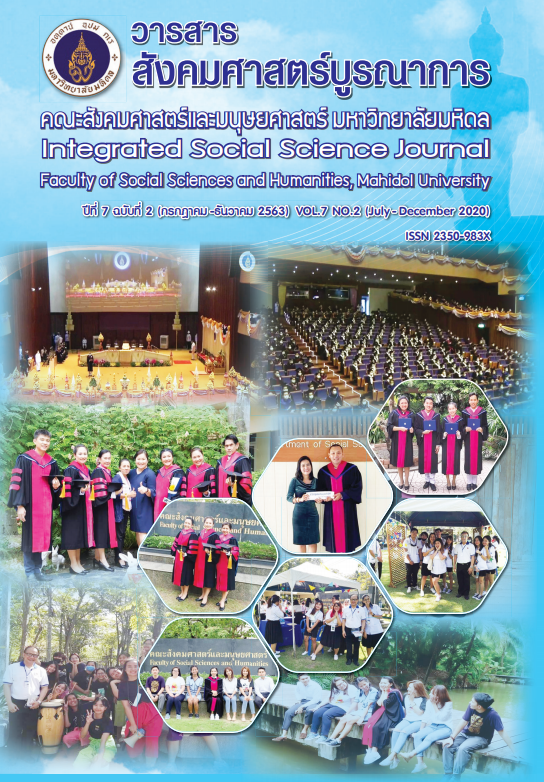ทางออกของความต่าง : การสร้างความปรองดองสมานฉันท์ในระบอบประชาธิปไตยไทย
Main Article Content
บทคัดย่อ
ความขัดแย้งทางการเมืองไทยในปัจจุบัน เป็นความขัดแย้งที่มีความเห็นต่าง แม้ทุกฝ่ายจะเห็นตรงกันว่า ระบอบประชาธิปไตยอันมีพระมหากษัตริย์ทรงเป็นประมุข เป็นระบอบการปกครองที่มีความเหมาะสมกับสังคมไทย แต่ก็ยังมีความต่างทางความคิด การให้คุณค่าระบอบประชาธิปไตย การให้ความสำคัญกับการเลือกตั้ง การเป็นตัวแทนของประชาชน การให้ความสำคัญกับคุณธรรม ความซื่อสัตย์สุจริตของผู้นำประเทศ มีข้อสงสัยที่ยังไม่สามารถค้นหาและทำความจริงให้ปรากฏเป็นที่ยอมรับในสังคมไทยและนานาประเทศ ข้อเท็จจริงที่เป็นรากเหง้าของปัญหาความขัดแย้ง การชุมนุมทางการเมือง การละเมิดสิทธิมนุษยชน การสูญเสียชีวิต การบาดเจ็บทางร่างกายและจิตใจ ความเสียหายของทรัพย์สิน และความเสียหายในรูปแบบอื่นๆ ที่เกิดขึ้นให้ปรากฏเป็นที่ประจักษ์ถึงสาเหตุของปัญหาความขัดแย้งที่สั่งสมจนทำให้เกิดความแตกแยกในสังคม เป้าหมายที่จะให้เกิดความเข้าใจร่วมกัน การเยียวยา และการป้องกันมิให้เกิดเหตุความรุนแรงและความเสียหายซ้ำอีก
ผู้เขียนเห็นว่า การสร้างความปรองดองให้เกิดขึ้นในสังคมน่าจะเป็นทางออกของความต่าง : การสร้างความปรองดองสมานฉันท์ในระบอบประชาธิปไตยไทย คือ 1) เจตจํานงทางการเมืองของผู้นํารัฐบาลและความเข้มแข็งของภาคประชาสังคมในการผลักดันขับเคลื่อนการสร้างความปรองดอง 2) เปิดพื้นที่ทางการเมืองเพื่อสร้างบรรยากาศถึงความเป็นไปได้ในการหาทางออกร่วมกัน 3) การพูดคุยเจรจาทุกฝ่ายด้วยกระบวนการที่ยอมรับของกลุ่มพลังในสังคม 4) เหตุแห่งความขัดแย้งได้รับการแก้ไขหรือจัดการภายใต้กลไกที่ชอบธรรมอันนำไปสู่สังคมร่วมกัน 5) การมีคำอธิบายต่อเหตุการณ์ที่กระทบความรู้สึกของสังคม การยอมรับการกระทำผิดอย่างจริงใจและการให้อภัยต่อกันและกัน
Article Details
- วารสารสังคมศาสตร์บูรณาการ มหาวิทยาลัยมหิดล อนุญาตให้สามารถนำไฟล์บทความไปใช้ประโยชน์และเผยแพร่ต่อได้ โดยอยู่ภายใต้เงื่อนไขสัญญาอนุญาต CC Attribution-NonCommercial-NoDerivatives 4.0 International (CC BY-NC-ND 4.0) โดยต้องแสดงที่มา/การอ้างอิงจากวารสาร – ไม่ใช้เพื่อการค้า – ห้ามแก้ไขดัดแปลงเนื้อหา
- ข้อความที่ปรากฏในบทความในวารสารฯ เป็นความคิดเห็นส่วนตัวของผู้เขียนแต่ละท่าน ไม่เกี่ยวข้องกับกองบรรณาธิการวารสารฯ (ซึ่งหมายรวมถึง บรรณาธิการ ผู้ทรงคุณวุฒิในกองบรรณาธิการ หรือ บรรณาธิการรับเชิญ) แต่อย่างใด ความรับผิดชอบองค์ประกอบทั้งหมดของบทความแต่ละเรื่องเป็นของผู้เขียนแต่ละท่าน หากมีความผิดพลาดใด ๆ ผู้เขียนแต่ละท่านจะรับผิดชอบบทความของตนเอง ตลอดจนความรับผิดชอบด้านเนื้อหาและการตรวจร่างบทความเป็นของผู้เขียน ไม่เกี่ยวข้องกับกองบรรณาธิการวารสารฯ
- กองบรรณาธิการขอสงวนสิทธิ์ในการตัดทอน/ปรับแก้ถ้อยคำบางประการเพื่อความเหมาะสม
เอกสารอ้างอิง
Boraine, Alexander. (2006). Transitional Justice. A Holistic Interpretation, in: Journal of International Affairs 60, 1, 17-27.
Bar-On, Dan. (2007). Reconciliation Revisited for More Conceptual and Empirical Clarity, in: Janja Bec-Neumann (ed.). Darkness at Noon. War Crimes, Genocide and Memories. Sarajevo: Centre for Interdisciplinary Postgraduate Studies, 62-84.
Bar-Tal, Daniel and Gemma H. Bennink. (2004). The Nature of Reconciliation as an Outcome and a Process, in: Yaacov Bar-Siman-Tov (ed.). From Conflict Resolution to Reconciliation. Oxford: Oxford University Press, 11-38.
Bloomfield, David. (2003). “Reconciliation: An Introduction,” in Reconciliation after Violent Conflict: A Handbook, ed. David Bloomfield. Stockholm: International IDEA.
Brouneus, Karen. (2003). Reconciliation – Theory and Practice for Development Copperation. Sweden: International Development Cooperation Agency.
Daniel Bar-Tal, speech held at the “Stockholm International Forum: Truth, Justice and Reconciliation”, April 23–24, 2002
Ericson, Maria. (2001).Reconciliation and the Search for a Shared Moral Landscape: An Exploration Based Upon a Study of Northern Ireland and South Africa. Frankfurt am Main; New York).
Fischer, M. (2011). Transitional Justice and Reconciliation : Theory and Practice.
Galtung, Johan.(1996). Peace by Peaceful Means. London: Sage.
Galtung, John. (2001). “After Violence, Reconstruction, Reconciliation, and Resolution: Coping with Visible and Invisible Effects,” in Reconciliation, Justice, and coexistence: Theory and Practice, ed. Mohammed Abu-Nimer. Lanham,Maryland: Lexington Books).
Hayner, Princilla. (2010). Unspeakable Truths: Confronting State Terror and Atrocity. United Kingdom: Roudtledge.
Kelman, Herbert C. (2010) "Conflict Resolution and Reconciliation: A Social-Psychological Perspective on Ending Violent Conflict Between Identity Groups," Landscapes of Violence: Vol. 1 : No. 1 , Article 5. DOI: 10.7275/R5H12ZX0 Available at: https://scholarworks.umass.edu/lov/vol1/iss1/5
Kriesberg, Louis. (2001). “Changing Forms of Coexistence,” in Reconciliation, Justice, and Coexistence: Theory and Practice, ed. Mohammed Abu-Nimer (Lanham, Maryland: Lexington Books.
Kriesberg, Louis. (2007). External Contributions to Post-Mass-Crime Rehabilitation, in: Beatrice Pouligny, Simon Chesterman and Albrecht Schnabel (eds.). After Mass Crime. Rebuilding States and Communities. New York: United Nations University, 243-271.
Lederach, John Paul. (1997). Building Peace: Sustainable Reconciliation in Divided Societies Washington, D.C.: United States: Institute of Peace Press.
Long, W. J., and P. Brecke, “The Emotive Causes of Recurrent International Conflict,” Politics and the Life Sciences, Vol. 22, No. 1 (March 2003), pp. 24-35
Miall, Hugh. (2004). Conflict Transformation: A Multi-Dimensional Task, in: Alex Austin, Martina Fischer and Norbert Ropers (eds.). Transforming Ethnopolitical Conflict. The Bergh of Handbook. Wiesbaden: VS Verlag, 67-90. Available at www.berghof-handbook.net.
Supalak Ganjanakhundee. (2020). Youthquake Evokes the 1932 Revolution and Shakes Thailand’s Establishment. Perspectives, ISSUE: 2020 No. 127, ISEAS Yusof Ishak Institute. Available at https://www.iseas.edu.sg/wp-ontent/uploads/2020/10/ISEAS Perspective_2020_127.pdf
Truth for Reconciliation Commission of Thailand. (2012). Final Report of Truth for Reconciliation Commission of Thailand (TRCT) 2012. Bangkok: Truth for Reconciliation Commission of Thailand.
คณะกรรมการอิสระตรวจสอบและค้นหาความจริงเพื่อการปรองดองแห่งชาติ (คอป.). (2555). รายงานฉบับสมบูรณ์ คณะกรรมการอิสระตรวจสอบและค้นหาความจริงเพื่อการปรองดองแห่งชาติ (คอป.) กรกฎาคม 2553 - กรกฎาคม 2555 : สารจากประธานและกรรมการ. กรุงเทพฯ: คณะกรรมการอิสระตรวจสอบและค้นหาความจริงเพื่อการปรองดองแห่งชาติ (คอป.).
Wuthisarn Thanchai et al. (2012). Final Report on Building Reconciliation for Thailand. Bangkok: King Prajadhipok's Institute.
วุฒิสาร ตันไชยและคณะ. (2555). รายงานวิจัยการสร้างความปรองดองแห่งชาติ. กรุงเทพฯ: สถาบันพระปกเกล้า.
Van der Merwe, Hugo. (1999).The Truth and Reconciliation Commission and Community Reconciliation: An Analysis of Competing Strategies and Conceptualizations. US: George Mason University.


